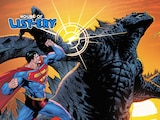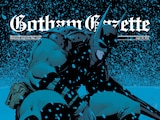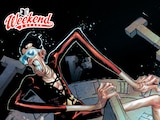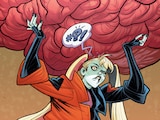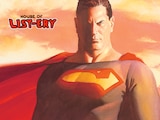Welcome back to another monthly installment of “ASK… THE QUESTION.” I’m Alex Jaffe, better known in our illustrious Community as HubCityQuestion. For the past two years, I’ve had one mission: to take on any question you have about the DC Universe—no matter how strange, granular or obscure—and present you with a satisfactory answer. As a faithful steward of the truth, I offer my time in this weekly column to address these inquiries. If you’d like to submit one of your own, you can stop by my office at any time in our Community to state your case. For now, though, let’s get some answers!
SMALLVILLE & LOIS

KookieSuperApe asks:
What is the first instance of Lois Lane calling Clark Kent by the nickname “Smallville”? Where did that originate?
Like so much of what we take for granted about Superman, whether it’s Kryptonite or Jimmy Olsen, this piece of lore originates outside of the comic book sphere. Lois Lane’s pet name for her small-town rival is actually from television, in the Alan Burnett and Paul Dini-written three-part pilot of Superman: The Animated Series, “Last Son of Krypton,” back in 1996. It was the show’s way of cultivating a playful antagonism between the Daily Planet’s two star reporters, and it went on to be used throughout the show and its comic book tie-ins, such as Superman Adventures. This is why you never hear Lois use the nickname in, for instance, Lois & Clark: The New Adventures of Superman—for most of the series, it didn’t exist yet!
The first time the “Smallville” nickname was used outside of the Animated Universe was in Jeph Loeb and Tim Sale’s 1998 four-issue treatise on Big Blue and those most important to him, Superman: For All Seasons. Loeb went on to use the nickname in his subsequent comic runs on Superman beginning with 1999’s Superman #151, and it’s been part of the canon ever since.
The first live action Lois Lane to refer to Clark as “Smallville” is Erica Durance, on (appropriately enough) TV’s Smallville, in 2004. And the only time Clark has been called “Smallville” in a major motion picture was in 2016’s Batman v Superman: Dawn of Justice…not by Lois, but by Perry White!
SILVER MINING

Samleelongworth.81198 asks:
“What issue does the main Batman title switch over into the Silver Age, from Earth-2 to Earth-1?”
This is a question that requires some explanation before I get into it. In the 1950s, comic books entered what is now usually referred to by comic book collectors and aficionados as the “Silver Age,” where fanciful science fiction concepts began to permeate the medium as America entered the mid-century “space race” against the Soviet Union. More scientifically-minded heroes, such as Barry Allen and Hal Jordan, began to replace the then-dated likes of their predecessors as the Flash and Green Lantern respectively, Jay Garrick and Alan Scott. In 1961, writer Gardner Fox delineated the continuities of these early stories of the “Golden Age” heroes with their modern counterparts in The Flash #123, “Flash of Two Worlds”—clarifying that while the “contemporary” comics took place on the primary Earth-One, these prior comics featuring heroes from the late ’30s and ’40s were set on the neighboring Earth-Two.
In the cases of the Flash and Green Lantern, it’s easy to draw the line where one of these continuities ends and the other begins—it’s when a new guy takes up the costume and gets a newly renumbered volume. But what about Batman, whose first ongoing eponymous title ran continuously from 1940 until 2011? Where does Golden Age Batman end and Silver Age Batman begin?
As far as collectors are concerned, the absolute hard line of the Silver Age is July 1956, the month that Barry Allen debuted in DC’s Showcase #4. The Batman issue to hit shelves that month was Batman #102, featuring a story where Batman and Robin chase down an actor who is stricken with amnesia and believes he’s a caveman. Not a very narratively satisfying break, to be sure.

We could also say that the line is drawn when Barry Allen discovers it in The Flash #123. The contemporaneous Batman issue then would be Batman #142, where Batman and Robin run afoul of the Aztec god Tezcatlipoca (who would later cause some trouble for Wonder Woman in the ‘80s). Not quite satisfactory to me, either.
Here’s another wrinkle: continuity historians agree that the first story that MUST take place on Earth-One actually takes place years before Showcase #4, in 1952’s Superman #76—an issue which depicts Superman and Batman’s first meeting, despite appearing together as auxiliary members of the Justice Society of America in brief moments through the ‘40s. By eschewing their history with the JSA, Superman #76 allows a clear entry point into the Silver Age continuity stories of Superman, at least. There was no issue of Batman that month, but the following month’s Batman #71 featured a story about a gang boss locking Batman and Robin up in a “Jail for Heroes.” Also not quite the auspicious start we’re looking for to Silver Age canon.
To find a satisfactory division between Golden and Silver Age Batman stories, then, we’ll have to look for a significant change in status quo which occurs as closely as possible to the ‘50s debut of the Flash…or, at least, the debut of Hal Jordan as Green Lantern some years later, when the Silver Age is generally recognized to have begun in earnest. At this point, we’re entering the realm of opinion as opposed to fact, so you’ll have to hear my case and see if you agree. As I see it, there are a few significant points where one might want to draw the Golden Age/Silver Age line on Batman:

- Batman #92, 1955. This is a little bit earlier than Barry Allen’s debut, but as we established with Superman #76, that’s not necessarily a dealbreaker. Batman #92 features the debut of Ace the Bat-Hound, a thoroughly Silver Age concept and one which would herald many more “family friendly” changes to Batman’s world.
- Batman #100/101, 1956. It’s close enough to Showcase #4, and 100 is a nice, round number—totally reasonable to use as a demarcation line, if you’d like.
- Batman #164, 1964. I’ll admit this one is pretty late to be the start of the Silver Age for the Batman title, but there’s a strong argument to be made here. Batman #164 was the first issue to feature Batman’s “New Look,” dynamically changing the style to the contemporary pop art which would influence the Batman television series in the years to come. After all, when you think “Silver Age Batman,” isn’t Adam West’s portrayal the first image that comes to mind? If that’s the case for you, then #164 is where that Batman begins on the page.
HAVE GREEN, WILL TRAVEL

emeraldlantern asks:
“Swamp Thing can destroy its physical body and then reform it using the plants at another place. When did it first show this ability? Is it in Alan Moore’s run?”
Swamp Thing’s earliest feat of regeneration whatsoever is in 1971’s House of Secrets #92 by creators Len Wein and Bernie Wrightson, where the first Swamp Thing we ever meet, Alex Olsen, regenerates into the titular Swamp Thing from his original human form. Swamp Thing’s first post-transformative act of regeneration is depicted in 1973’s Swamp Thing #5, where the same team of Wein and Wrightson show Swamp Thing’s arm getting removed by a scythe, only for Swamp Thing to regenerate it later—and, later still, the discarded arm generates into a Swamp Thing of its own.
But Swamp Thing’s first act of total bodily regeneration is shown in 1985’s Swamp Thing #37, by Alan Moore and Rick Veitch. Aided by the tender care of Abby Arcane, Swamp Thing slowly returns from complete physical obliteration in a single plant. In the issues that follow, the reborn Swamp Thing becomes acquainted with a certain nasty hedge mage we know as John Constantine, who gradually teaches him to embrace the full extent of his powers as an elemental avatar of the Green. Indeed, Swamp Thing’s first instance of intentional decomposition and regeneration as a means of travel comes not much later, in Swamp Thing #39.

BAT’S ALL, FOLKS

Felix Leiter asks:
“Have Batman, Batwoman, Batwing and Batgirl ever worked on a case together? Is there a panel with all four of them in it?”
The first time all four of these Bats appear in the same issue is 2013’s Batwoman #24, but not all of them are working the same case…or even for the same side. Blackmailed by the DEO into helping them draw out Batman and his allies in order to save her sister, Batwoman is forced to fight Batman himself, while Bruce’s allies—Batwing and Batgirl included—help contain the DEO-orchestrated Arkham breakout designed as Bat-Bait.
The next incident where all four of these Bats appear together is 2014’s Detective Comics #27 and Catwoman #28, for the “Gothtopia” story arc. Here, a drugged and captive Batman dreams of an idealized Gotham that goes slowly wrong. But not only are the Batwing, Batgirl and Batwoman of that dream sequence imaginary, they’re also often working at counter-purposes—and never do all four appear in the same panel.
The first time these four appear together at once is on the cover of 2014’s Batman Eternal #1, with the busts of Batman’s allies all artistically draped in the shadow of Batman’s cape as drawn by Jason Fabok and Tomeu Morey. But this is an artistic interpretation of the characters who would be involved in the sprawling, weekly 52-issue story to follow, and the four don’t actually appear together in the issue itself. All four do make appearances, along with much of the rest of the Bat-Family, in the second issue, but they’re all separate scenes reacting to the shocking events of the first. That said, the story of Batman Eternal—the framing of Commissioner Gordon for an act of mass murder by a shadowy cabal of super-villains—can be said in earnest to be the first case that Batman, Batgirl, Batwoman and Batwing have all worked together, albeit separately throughout the series...until at last, all four Bats, along with the rest of their allies, finally converge to face down their true enemy at the crescendo of issue #52.

(That’s Batman on the floor there, in case you can’t tell. Shut up, it counts.)
JEWS FOR JUSTICE

kingofspeedsters asks:
“Are Batman and the Flash Jewish?”
Here’s the short version:
- Maybe.
- Maybe, but it depends where you look.
Here's the long version.
In the comics alone, there is no evidence that Bruce Wayne or Barry Allen were ever raised Jewish or had any Jewish presence in their home.
However, Judaism is unique among Western faiths, in that it is considered an ethnicity as well as a religion. In Orthodox Judaism, there is a concept known as matrilineality. Matrilineality means that even if you were not raised culturally or religiously Jewish, you maintain a Jewish identity by birth as long as your biological mother was Jewish herself. In other sects of Judaism, one is considered ethnically Jewish if either of their parents are Jewish.
Bruce Wayne’s mother, Martha Wayne, nee Kane, was not a practicing Jew. In fact, many comics adorn Martha’s grave with Christian iconography. However, one thing we do know is that Martha’s brother, Jacob Kane, is the father of Kate Kane, aka Batwoman.

We know that Kate Kane identifies as Jewish. And that Jacob Kane identifies as Jewish as well.
There has never been any direct evidence regarding the origin of Jacob Kane’s Judaism. We don’t know whether he converted for the sake of Kate’s mother, who was also Jewish, or whether he was Jewish by birth.
However, IF Jacob Kane is Jewish by birth, then that would mean that his sister, Martha, was Jewish by birth as well.
And this would mean that Batman is, matrilineally, Jewish.
Now, let’s talk about the Flash. As far as I know, there has never been any evidence or reference whatsoever in the comics that any member of Barry’s family, let alone Barry himself, is Jewish.

The films, though, are another story. In the 2017 theatrical cut of Justice League, Barry Allen has a line where he describes his own appearance to Batman as “a nice Jewish boy.” However, this line alone is not enough evidence to say for sure whether Barry is Jewish in these films. It might have been a serious declaration of his personal identity, or it might have been a meta-joke about the fact that Ezra Miller, the actor who plays Barry in the film, identifies as Jewish themselves via their Jewish father. Perhaps the subject of Barry’s Judaism will be elaborated upon in the upcoming Flash solo movie.
One thing I can say for sure, though? As we find out in Justice League: Darkseid War: Green Lantern #1, matrilineally speaking, Hal Jordan is DEFINITELY Jewish.
That’s all the time we have for this month, so I’ll catch you in the DC community where I’ll be taking additional questions all month. I’ve even been known to stop by in between columns to provide some answers. The only way we learn is through curiosity—so never be afraid to ASK… THE QUESTION.
Got something that's keeping you up nights? If you have a question about the DC Universe that you'd love to get answered, you can head on over to the DC Community and ask it here.
Alex Jaffe is the author of our monthly "Ask the Question" column and writes about TV, movies, comics and superhero history for DCComics.com. Follow him on Twitter at @AlexJaffe and find him in the DC Community as HubCItyQuestion.
NOTE: The views and opinions expressed in this column are solely those of Alex Jaffe and do not necessarily reflect those of DC Entertainment or Warner Bros.

